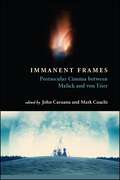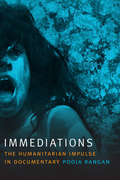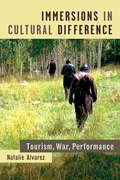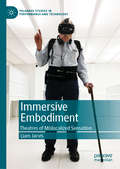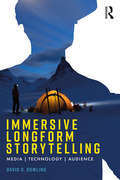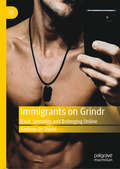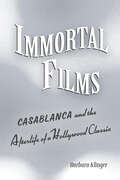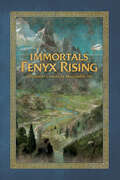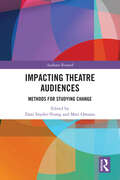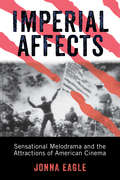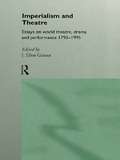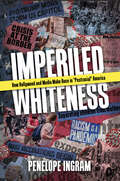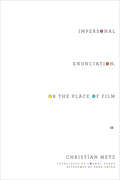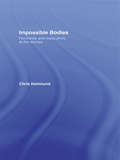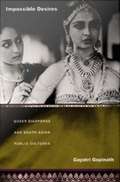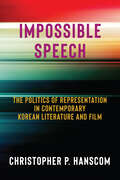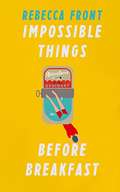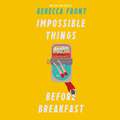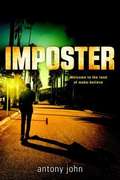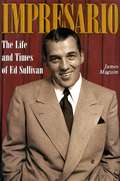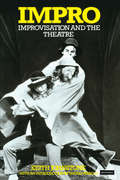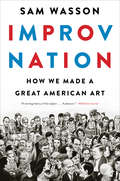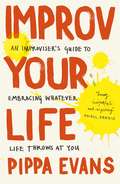- Table View
- List View
Immanent Frames: Postsecular Cinema between Malick and von Trier (SUNY series, Horizons of Cinema)
by John Caruana; Mark CauchiFor some time now, thinkers across the humanities and social sciences have increasingly called into question the once-dominant view of the relationship between modernity and secularism, prompting some to speak of a "postsecular turn." Until now, film studies has largely been silent about this development, even though cinema itself has been a major vehicle for such reflection. This fact became inescapable in 2011 when Terrence Malick's The Tree of Life and Lars von Trier's Melancholia were released within days of each other. While these two audacious and controversial films present seemingly opposite perspectives—the former a thoughtful meditation on faith, the latter a portrayal of nontriumphalist atheism—together they raise critical questions about transcendence and immanence in modern life. These films are, however, only the most conspicuous of a growing body of works that call forth similar and related questions—what this collection aptly calls "postsecular cinema."Taking the nearly simultaneous release of The Tree of Life and Melancholia as its starting point and framing device, this pioneering collection sets out to establish the idea of postsecular cinema as a distinct body of films and a viable critical category. Adopting a film-philosophy approach, one group of essays examines Malick's and von Trier's films, while another looks at works by Chantal Akerman, Denys Arcand, the Dardenne brothers, and John Michael McDonagh, among others. The volume closes with two important interviews with Luc Dardenne and Jean-Luc Nancy that invite us to reflect more deeply on some of the central concerns of postsecular cinema.
Immediations: The Humanitarian Impulse in Documentary
by Pooja RanganEndangered life is often used to justify humanitarian media intervention, but what if suffering humanity is both the fuel and outcome of such media representations? Pooja Rangan argues that this vicious circle is the result of immediation, a prevailing documentary ethos that seeks to render human suffering urgent and immediate at all costs. Rangan interrogates this ethos in films seeking to “give a voice to the voiceless,” an established method of validating the humanity of marginalized subjects, including children, refugees, autistics, and animals. She focuses on multiple examples of documentary subjects being invited to demonstrate their humanity: photography workshops for the children of sex workers in Calcutta; live eyewitness reporting by Hurricane Katrina survivors; attempts to facilitate speech in nonverbal autistics; and painting lessons for elephants. These subjects are obliged to represent themselves using immediations—tropes that reinforce their status as the “other” and reproduce definitions of the human that exclude non-normative modes of thinking, being, and doing. To counter these effects, Rangan calls for an approach to media that aims not to humanize but to realize the full, radical potential of giving the camera to the other.
Immersions in Cultural Difference: Tourism, War, Performance
by Natalie AlvarezIn a time of intensifying xenophobia and anti-immigration measures, this book examines the impulse to acquire a deeper understanding of cultural others. Immersions in Cultural Difference takes readers into the heart of immersive simulations, including a simulated terrorist training camp in Utah; mock Afghan villages at military bases in Canada and the UK; a fictional Mexico-US border run in Hidalgo, Mexico; and an immersive tour for settlers at a First Nations reserve in Manitoba, Canada. Natalie Alvarez positions the phenomenon of immersive simulations within intersecting cultural formations: a neoliberal capitalist interest in the so-called “experience economy” that operates alongside histories of colonization and a heightened state of xenophobia produced by War on Terror discourse. The author queries the ethical stakes of these encounters, including her own in relation to the field research she undertakes. As the book moves from site to site, the reader discovers how these immersions function as intercultural rehearsal theaters that serve a diverse set of strategies and pedagogical purposes: they become a “force multiplier” within military strategy, a transgressive form of dark tourism, an activist strategy, and a global, profit-generating practice for a neoliberal capitalist marketplace.
Immersive Embodiment: Theatres of Mislocalized Sensation (Palgrave Studies in Performance and Technology)
by Liam JarvisThis book offers a wide-ranging examination of acts of ‘virtual embodiment’ in performance/gaming/applied contexts that abstract an immersant’s sense of physical selfhood by instating a virtual body, body-part or computer-generated avatar. Emergent ‘immersive’ practices in an increasingly expanding and cross-disciplinary field are coinciding with a wealth of new scientific knowledge in body-ownership and self-attribution. A growing understanding of the way a body constructs its sense of selfhood is intersecting with the historically persistent desire to make an onto-relational link between the body that ‘knows’ an experience and bodies that cannot know without occupying their unique point of view. The author argues that the desire to empathize with another’s ineffable bodily experiences is finding new expression in contexts of particular urgency. For example, patients wishing to communicate their complex physical experiences to their extended networks of support in healthcare, or communities placing policymakers ‘inside’ vulnerable, marginalized or disenfranchised virtual bodies in an attempt to prompt personal change. This book is intended for students, academics and practitioner-researchers studying or working in the related fields of immersive theatre/art-making, arts-science and VR in applied performance practices.
Immersive Longform Storytelling: Media, Technology, Audience
by David DowlingA deep dive into the world of online and multimedia longform storytelling, this book charts the renaissance in deep reading, viewing and listening associated with the literary mind, and the resulting implications of its rise in popularity. David O. Dowling argues that although developments in media technology have enabled the ascendance of nonfictional storytelling to new heights through new forms, it has done so at the peril of these intensely persuasive designs becoming deployed for commercial and political purposes. He shows how traditional boundaries separating genres and dividing editorial from advertising content have fallen with the rise of media hybridity, drawing attention to how the principle of an independent press can be reformulated for the digital ecosystem. Immersive Longform Storytelling is a compelling examination of storytelling, covering multimedia features, on-demand documentary television, branded digital documentaries, interactive online documentaries, and podcasting. This book’s focus on both form and effect makes it a fascinating read for scholars and academics interested in storytelling and the rise of new media.
Immigrants on Grindr: Race, Sexuality and Belonging Online
by Andrew DJ ShieldThis book examines the role of hook-up apps in the lives of gay, bi, trans, and queer immigrants and refugees, and how the online culture of these platforms promotes belonging or exclusion. Within the context of the so-called European refugee crisis, this research focuses on the experiences of immigrants from especially Muslim-majority countries to the greater Copenhagen area, a region known for both its progressive ideologies and its anti-immigrant practices. Grindr and similar platforms connect newcomers with not only dates and sex, but also friends, roommates and other logistical contacts. But these socio-sexual platforms also become spaces of racialization and othering. Weaving together analyses of real Grindr profile texts, immigrant narratives, political rhetoric, and popular media, Immigrants on Grindr provides an in-depth look at the complex interplay between online and offline cultures, and between technology and society.
Immortal Films: "Casablanca" and the Afterlife of a Hollywood Classic
by Barbara KlingerCasablanca is one of the most celebrated Hollywood films of all time, its iconic romance enshrined in collective memory across generations. Drawing from archival materials, industry trade journals, and cultural commentary, Barbara Klinger explores the history of Casablanca's circulation in the United States from the early 1940s to the present by examining its exhibition via radio, repertory houses, television, and video. By resituating the film in the dynamically changing industrial, technological, and cultural circumstances that have defined its journey over eight decades, Klinger challenges our understanding of its meaning and reputation as both a Hollywood classic and a cult film. Through this single-film survey, Immortal Films proposes a new approach to the study of film history and aesthetics and, more broadly, to cinema itself as a medium in constant interface with other media as a necessary condition of its own public existence and endurance.
Immortals Fenyx Rising: A Traveler's Guide to the Golden Isle
by Rick Barba UbisoftWelcome to Chryse, the Golden Isle! The king of the gods himself, Zeus, presents you with this indispensable travel guide to the ancient Greek island from Ubisoft&’s Immortals Fenyx Rising video game.Follow the king of the gods on an expedition across the different regions of the dazzling island of Chryse: whether strolling through the lush painted gardens of the goddess Aphrodite, battling inside Ares&’s fortress, or planning a boat trip across the river Styx, this full-color travel guide will keep you alive and thriving. In this glorious hardcover, readers will discover all about each region&’s landmarks, secrets and legendary myths and will enjoy Zeus&’s hot goss on the rest of the pantheon! Immortals Fenyx Rising: A Traveler's Guide to the Golden Isle is a must have for any fan of Immortals Fenyx Rising and Greek mythology.
Impacting Theatre Audiences: Methods for Studying Change (Audience Research)
by Dani Snyder-Young Matt OmastaThis edited collection explores methods for conducting critical empirical research examining the potential impacts of theatrical events on audience members. Dani Snyder-Young and Matt Omasta present an overview of the burgeoning subfield of audience studies in theatre and performance studies, followed by an introduction to the wide range of ways scholars can study the experiences of spectators. Consisting of chapter length case studies, the book addresses methodologies for examining spectatorship, including qualitative, quantitative, historical/historiographic, arts-based, participatory, and mixed methods approaches. This volume will be of great interest to theatre and performance studies scholars as well as industry professionals working in marketing, audience development and community engagement.
Imperial Affects: Sensational Melodrama and the Attractions of American Cinema
by Jonna EagleImperial Affects is the first sustained account of American action-based cinema as melodrama. From the earliest war films through the Hollywood Western and the late-century action cinema, imperialist violence and mobility have been produced as sites of both visceral pleasure and moral virtue. Suffering and omnipotence operate as twinned affects in this context, inviting identification with an American national subject constituted as both victimized and invincible—a powerful and persistent conjunction traced here across a century of cinema.
Imperialism and Theatre: Essays On World Theatre, Drama, And Performance
by J. Ellen GainorImperialism is a transnational and transhistorical phenomenon; it occurs neither in limited areas nor at one specific moment. In cultures from across the world theatrical performance has long been a site for both the representation and support of imperialism, and resistance and rebellion against it. Imperialism and Theatre is a groundbreaking collection which explores the questions of why and how the theatre was selected within imperial cultures for the representation of the concerns of both the colonizers and the colonized. Gathering together fifteen noted scholars and theatre practitioners, this collection spans global and historical boundaries and presents a uniquely comprehensive study of post-colonial drama. The essays engage in current theoretical issues while shifting the focus from the printed text to theatre as a cultural formation and locus of political force. A compelling and extremely timely work, Imperialism and Theatre reveals fascinating new dimensions to the post-colonial debate. Contributors: Nora Alter; Sudipto Chatterjee; Mary Karen Dahl; Alan Filewood; Donald H. Frischmann; Rhonda Garelick; Helen Gilbert; Michael Hays; Loren Kruger; Josephine Lee; Robert Eric Livingston; Julie S. Peters; Michael Quinn; Edward Said; Elaine Savory.
Imperiled Whiteness: How Hollywood and Media Make Race in "Postracial" America
by Penelope IngramIn Imperiled Whiteness, Penelope Ingram examines the role played by media in the resurgence of white nationalism and neo-Nazi movements in the Obama-to-Trump era. As politicians on the right stoked anxieties about whites “losing ground” and “being left behind,” media platforms turned whiteness into a commodity that was packaged and disseminated to a white populace. Reading popular film and television franchises (Planet of the Apes, Star Trek, and The Walking Dead) through political flashpoints, such as debates over immigration reform, gun control, and Black Lives Matter protests, Ingram reveals how media cultivated feelings of white vulnerability and loss among white consumers. By exploring the convergence of entertainment, news, and social media in a digital networked environment, Ingram demonstrates how media’s renewed attention to “imperiled whiteness” enabled and sanctioned the return of overt white supremacy exhibited by alt-right groups in the “Unite the Right” rally in Charlottesville in 2017 and the Capitol riots in 2021.
Impersonal Enunciation, or the Place of Film
by Dana Polan Cormac Deane Christian MetzChristian Metz is best known for applying Saussurean theories of semiology to film analysis. In the 1970s, he used Sigmund Freud's psychology and Jacques Lacan's mirror theory to explain the popularity of cinema. In this final book, Metz uses the concept of enunciation to articulate how films "speak" and explore where this communication occurs, offering critical direction for theorists who struggle with the phenomena of new media. If a film frame contains another frame, which frame do we emphasize? And should we consider this staging an impersonal act of enunciation? Consulting a range of genres and national trends, Metz builds a novel theory around the placement and subjectivity of screens within screens, which pulls in-and forces him to reassess-his work on authorship, film language, and the position of the spectator. Metz again takes up the linguistic and theoretical work of Benveniste, Genette, Casetti, and Bordwell, drawing surprising conclusions that presage current writings on digital media. Metz's analysis enriches work on cybernetic emergence, self-assembly, self-reference, hypertext, and texts that self-produce in such a way that the human element disappears. A critical introduction by Cormac Deane bolsters the connection between Metz's findings and nascent digital-media theory, emphasizing Metz's keen awareness of the methodological and philosophical concerns we wrestle with today.
Impersonal Enunciation, or the Place of Film (Film and Culture Series)
by Christian MetzChristian Metz is best known for applying Saussurean theories of semiology to film analysis. In the 1970s, he used Sigmund Freud's psychology and Jacques Lacan's mirror theory to explain the popularity of cinema. In this final book, Metz uses the concept of enunciation to articulate how films "speak" and explore where this communication occurs, offering critical direction for theorists who struggle with the phenomena of new media. If a film frame contains another frame, which frame do we emphasize? And should we consider this staging an impersonal act of enunciation? Consulting a range of genres and national trends, Metz builds a novel theory around the placement and subjectivity of screens within screens, which pulls in—and forces him to reassess—his work on authorship, film language, and the position of the spectator. Metz again takes up the linguistic and theoretical work of Benveniste, Genette, Casetti, and Bordwell, drawing surprising conclusions that presage current writings on digital media. Metz's analysis enriches work on cybernetic emergence, self-assembly, self-reference, hypertext, and texts that self-produce in such a way that the human element disappears. A critical introduction by Cormac Deane bolsters the connection between Metz's findings and nascent digital-media theory, emphasizing Metz's keen awareness of the methodological and philosophical concerns we wrestle with today.
Impossible Bodies: Femininity and Masculinity at the Movies (Comedia)
by Christine HolmlundImpossible Bodies investigates issues of ethnicity, gender, and sexuality in contemporary Hollywood. Examining stars from Arnold Schwarzenegger and Clint Eastwood, to Whoopi Goldberg and Jennifer Lopez, Holmlund focuses on actors whose physique or appearance marks them as unusual or exceptional, and yet who occupy key and revealing positions in today's mainstream cinema. Exploring a range of genres and considering both stars and their sidekicks, Holmlund examines ways in which Hollywood accommodates - or doesn't - a variety of 'impossible' bodies, from the 'outrageous' physiques of Dolph Lundgren and Dolly Parton, to the almost-invisible bodies of Asian-Americans, Latinas and older actors.
Impossible Desires: Queer Diasporas and South Asian Public Cultures
by Gayatri GopinathBy bringing queer theory to bear on ideas of diaspora, Gayatri Gopinath produces both a more compelling queer theory and a more nuanced understanding of diaspora. Focusing on queer female diasporic subjectivity, Gopinath develops a theory of diaspora apart from the logic of blood, authenticity, and patrilineal descent that she argues invariably forms the core of conventional formulations. She examines South Asian diasporic literature, film, and music in order to suggest alternative ways of conceptualizing community and collectivity across disparate geographic locations. Her agile readings challenge nationalist ideologies by bringing to light that which has been rendered illegible or impossible within diaspora: the impure, inauthentic, and nonreproductive. Gopinath juxtaposes diverse texts to indicate the range of oppositional practices, subjectivities, and visions of collectivity that fall outside not only mainstream narratives of diaspora, colonialism, and nationalism but also most projects of liberal feminism and gay and lesbian politics and theory. She considers British Asian music of the 1990s alongside alternative media and cultural practices. Among the fictional works she discusses are V. S. Naipaul's classic novel A House for Mr. Biswas, Ismat Chughtai's short story "The Quilt," Monica Ali's Brick Lane, Shyam Selvadurai's Funny Boy, and Shani Mootoo's Cereus Blooms at Night. Analyzing films including Deepa Mehta's controversial Fire and Mira Nair's Monsoon Wedding, she pays particular attention to how South Asian diasporic feminist filmmakers have reworked Bollywood's strategies of queer representation and to what is lost or gained in this process of translation. Gopinath's readings are dazzling, and her theoretical framework transformative and far-reaching.
Impossible Speech: The Politics of Representation in Contemporary Korean Literature and Film
by Christopher HanscomIn what ways can or should art engage with its social context? Authors, readers, and critics have been preoccupied with this question since the dawn of modern literature in Korea. Advocates of social engagement have typically focused on realist texts, seeing such works as best suited to represent injustices and inequalities by describing them as if they were before our very eyes.Christopher P. Hanscom questions this understanding of political art by examining four figures central to recent Korean fiction, film, and public discourse: the migrant laborer, the witness to or survivor of state violence, the refugee, and the socially excluded urban precariat. Instead of making these marginalized figures intelligible to common sense, this book reveals the capacity of art to address the “impossible speech” of those who are not asked, expected, or allowed to put forward their thoughts, yet who in so doing expand the limits of the possible.Impossible Speech proposes a new approach to literature and film that foregrounds ostensibly “nonpolitical” or nonsensical moments, challenging assumptions about the relationship between politics and art that locate the “politics” of the work in the representation of content understood in advance as being political. Recasting the political as a struggle over the possibility or impossibility of speech itself, this book finds the politics of a work of art in its power to confront the boundaries of what is sayable.
Impossible Things Before Breakfast: Adventures in the Ordinary
by Rebecca Front'Hilarious' The Times'I was completely captivated' David SedarisPeople are odd. Even the most predictable of us sometimes defy expectations. Add to that the tricks that life plays on us and the world suddenly seems full of impossible things.As an award-winning actor and writer, Rebecca Front has always been fascinated by life's little quirks. Impossible Things Before Breakfast is a collection of true stories about surprising turns of events, bizarre misunderstandings and improbable life lessons. We learn, among other things, how gazing at the stars can help you communicate with teenagers, how a mushroom can undermine an ancient ritual, and why everyone should wear a cape.Combining elegant writing, wry humour and genuine insight, this brilliant collection prises open the lid on ordinary life and feasts on the impossible.
Impossible Things Before Breakfast: Adventures in the Ordinary
by Rebecca FrontPeople are odd. Even the most predictable of us sometimes defy expectations. Add to that the tricks that life plays on us and the world suddenly seems full of impossible things.As an award-winning actor and writer, Rebecca Front has always been fascinated by life's little quirks. Impossible Things Before Breakfast is a collection of true stories about surprising turns of events, bizarre misunderstandings and improbable life lessons. We learn, among other things, how gazing at the stars can help you communicate with teenagers, how a mushroom can undermine an ancient ritual, and why everyone should wear a cape.Combining elegant writing, wry humour and genuine insight, this brilliant collection prises open the lid on ordinary life and feasts on the impossible.
Impossible Things Before Breakfast: Adventures in the Ordinary
by Rebecca FrontPeople are odd. Even the most predictable of us sometimes defy expectations. Add to that the tricks that life plays on us and the world suddenly seems full of impossible things.As an award-winning actor and writer, Rebecca Front has always been fascinated by life's little quirks. Impossible Things Before Breakfast is a collection of true stories about surprising turns of events, bizarre misunderstandings and improbable life lessons. We learn, among other things, how gazing at the stars can help you communicate with teenagers, how a mushroom can undermine an ancient ritual, and why everyone should wear a cape.Combining elegant writing, wry humour and genuine insight, this brilliant collection prises open the lid on ordinary life and feasts on the impossible.Written and Read by Rebecca Front(p) Orion Publishing Group 2018
Imposter
by Antony JohnPerfect for fans of Veronica Mars, this Hollywood thriller explores the blurred lines between Hollywood glamour and reality. Seth Crane has hit rock bottom. His mom recently died, his dad had a stroke and is out of work, and he just lost out on a commercial role. So when a producer shows up at his community theater production and offers him the lead role in an Indie film with major Hollywood buzz, it seems like the answer to all Seth's problems. Seth gets swept up in the Hollywood glamour right away, staying in a fancy hotel, going to the best parties, doing press conferences, and falling for the beautiful starlet Sabrina Layton and then his costar Annaleigh. But things suddenly start popping up in the tabloids--things Sabrina and Annaleigh told him in confidence and that no one else could know--and the line between the film and reality starts to blur. Nothing in Hollywood is what it seems, and Seth has to decide just how far he's willing to go for fame, money, and to protect the people he loves.
Impresario: The Life and Times of Ed Sullivan
by James MaguireEd Sullivan has nearly 100% name recognition among people 40 and older. In a survey of the fifty most influential programs in the U.S., TV Guide ranked The Ed Sullivan Show #10. The show still appears on PBS and on cable stations across the country. Sixty million baby boomers grew up watching The Ed Sullivan Show. For more than twenty years, from 1948 to 1971, fifty-five million viewers watched The Ed Sullivan Show religiously every Sunday night. Everyone who was anyone appeared--the Beatles and Elvis, of course, and Woody Allen, Bill Cosby, and Elizabeth Taylor, plus public figures such as Fidel Castro, David Ben-Gurion, and Martin Luther King, Jr. More than thirty years later, the program remains a pop-culture icon. But despite Ed Sullivan's prominence, little was known about the private man...until now. Impresario reveals what the Sullivan viewers never saw: nasty, hot-tempered, craven, yet also capable of high ideals and, above all, hugely ambitious. At a time when Americans are looking back, The Ed Sullivan Show stands out as a shining example of television during the golden era. Impresario lets readers look behind the screen to see the man who made it happen.
Impro: Improvisation and the Theatre (Bloomsbury Revelations Ser.)
by Keith JohnstoneKeith Johnstone's involvement with the theatre began when George Devine and Tony Richardson, artistic directors of the Royal Court Theatre, commissioned a play from him. This was in 1956. A few years later he was himself Associate Artistic Director, working as a play-reader and director, in particular helping to run the Writers' Group. The improvisatory techniques and exercises evolved there to foster spontaneity and narrative skills were developed further in the actors' studio then in demonstrations to schools and colleges and ultimately in the founding of a company of performers, called The Theatre Machine. Divided into four sections, 'Status', 'Spontaneity', 'Narrative Skills', and 'Masks and Trance', arranged more or less in the order a group might approach them, the book sets out the specific techniques and exercises which Johnstone has himself found most useful and most stimulating. The result is both an ideas book and a fascinating exploration of the nature of spontaneous creativity.
Improv Nation: How We Made a Great American Art
by Sam WassonA finalist for the 2017 George Freedley Memorial Award &“A compelling, absolutely unputdownable story . . . And, in case you&’re wondering, yes, the book is funny. In places, very funny. A remarkable story, magnificently told.&” — Booklist In this richly reported, scene-driven narrative, Sam Wasson charts the meteoric rise of improv from its unlikely beginnings in McCarthy-era Chicago. We witness the chance meeting between Mike Nichols and Elaine May, hang out at the after-hours bar where Dan Aykroyd hosted friends like John Belushi, Bill Murray, and Gilda Radner, and go behind the scenes of cultural landmarks from The Graduate to The Colbert Report. Along the way, we befriend pioneers such as Harold Ramis, Chevy Chase, Steve Carell, Amy Poehler, Alan Arkin, Tina Fey, Judd Apatow, and many others. Wasson shows why improv deserves to be considered the great American art form of the last half century. &“One of the most important stories in American popular culture . . . Wasson may be the first author to explain [improv&’s] entire history . . . For that reason alone, it&’s a valuable book.&” — New York Times Book Review &“A compelling history . . . It holds the element of surprise—true to the spirit of its subject.&” — Entertainment Weekly
Improv Your Life
by Pippa Evans'If you want to be more present, more reactive and have more fun - this book is for you' SARA PASCOE'Funny, insightful and inspiring' RACHEL PARRIS'Essential reading for anyone wanting to do life, but better' CARIAD LLOYD'A wonderfully witty, charmingly personal guide to the art of improvisation for the stage & life' DEBORAH FRANCES WHITEAn improviser's guide to embracing whatever life throws at you!PIPPA EVANS is an expert in saying Yes - and No. She's a master of thinking on her feet, but has also had to learn how to go with the flow. In this book she's passing on everything she's learnt from her award winning improv career, as both a performer and teacher, so YOU can take centre stage in your own life.In telling her story, delving into the craft of improvisation, and sharing fun exercises and practice you can do at home, Pippa will help you become fully yourself - realising your potential and ability to adapt to the ever changing world around you. It's dangerous, being yourself, but let's just take it one step at a time. Open the book, take a breath and get ready to say YES. (If it's a NO from you then perhaps consider buying for a friend, family member or enemy who you think needs some improv-ment)
